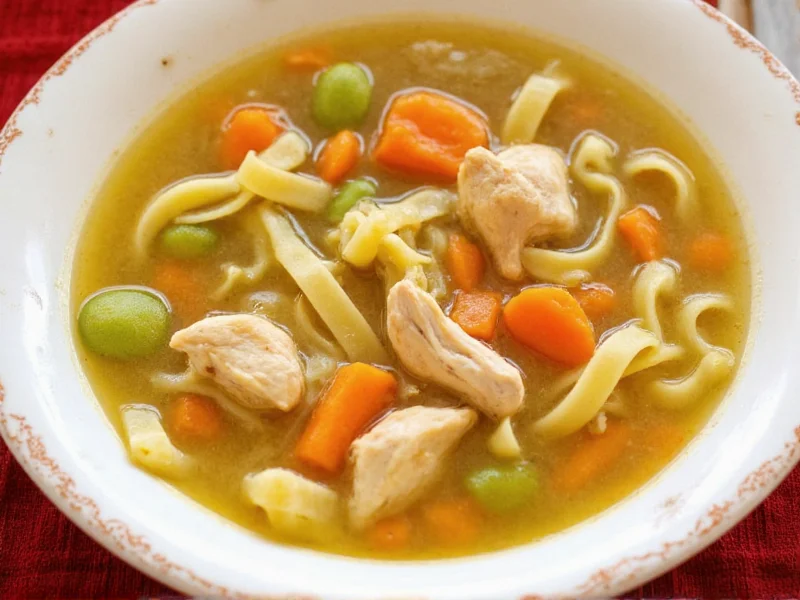Creating exceptional chicken noodle soup requires understanding the balance between broth depth, vegetable texture, and noodle consistency. While many quick versions exist, the most satisfying results come from building flavors gradually rather than rushing the process. This guide provides a time-tested method that delivers comforting, restaurant-quality soup in about 90 minutes with minimal specialized equipment.
Essential Ingredients for Authentic Chicken Noodle Soup
Quality ingredients form the foundation of memorable chicken noodle soup. Selecting the right components makes a significant difference in your final result:
| Ingredient | Quantity | Key Purpose |
|---|---|---|
| Bone-in chicken thighs | 1.5 lbs (680g) | Provides rich flavor and tender meat that won't dry out during simmering |
| Yellow onions | 1 large, diced | Creates aromatic base without overpowering sweetness |
| Carrots | 3 medium, sliced 1/4-inch thick | Adds natural sweetness and texture |
| Celery stalks | 3 medium, sliced 1/4-inch thick | Contributes herbal notes and complexity |
| Egg noodles | 8 oz (225g) dried | Traditional choice that holds shape during cooking |
| Fresh parsley | 3 tbsp chopped | Provides bright finish and visual appeal |
Step-by-Step Chicken Noodle Soup Preparation
Building the Flavor Foundation
Begin by placing chicken thighs in a large stockpot with 8 cups of cold water. Bring to a gentle simmer over medium heat—never a rolling boil, which makes broth cloudy. Skim any foam that rises to the surface during the first 10 minutes. Add 1 teaspoon of salt to the pot while simmering.
After 45 minutes of gentle simmering, remove chicken pieces and set aside to cool. Strain the broth through a fine-mesh sieve into a clean container, discarding solids. This creates your clean base for the soup. Proper broth preparation represents the most critical step in making homemade chicken noodle soup from scratch.
Vegetable Sautéing Technique
While broth simmers, heat 2 tablespoons of olive oil in the same pot over medium heat. Add onions, carrots, and celery, cooking until onions become translucent (about 7 minutes). This traditional chicken noodle soup vegetable preparation develops flavor through controlled caramelization without browning.
Final Assembly and Simmering
Return the strained broth to the pot with sautéed vegetables. Bring to a gentle simmer and cook for 15 minutes to allow flavors to meld. While broth simmers, remove skin and bones from cooled chicken, then shred meat into bite-sized pieces.
Add shredded chicken to the pot along with 1 teaspoon dried thyme and 1 bay leaf. Return to a simmer, then add egg noodles. Cook for 8-10 minutes until noodles reach al dente texture. Overcooking noodles creates mushy results that ruin the perfect chicken noodle soup consistency.
Professional Tips for Superior Results
Seasoning properly makes the difference between good and exceptional soup. Add salt gradually during cooking, tasting before final seasoning. The broth should taste slightly saltier than desired since noodles will absorb some seasoning.
For quick chicken noodle soup preparation without sacrificing quality, use pre-cooked rotisserie chicken but still simmer bones with water for 30 minutes to create a light broth base. This approach cuts total preparation time to under 45 minutes while maintaining depth of flavor.
Adding noodles directly to the soup pot creates starch buildup that thickens the broth. For restaurant-style clarity, cook noodles separately and add to individual bowls before ladling soup over them. This technique prevents common chicken noodle soup mistakes like soggy noodles or overly thickened broth.
Storage and Reheating Guidelines
Properly stored, chicken noodle soup maintains quality for 4-5 days in the refrigerator. For best results, store broth and noodles separately if possible. When reheating, add a splash of water or additional broth to compensate for liquid absorption.
Freezing soup with noodles results in texture degradation upon thawing. For freezing chicken noodle soup successfully, omit noodles when freezing and add freshly cooked noodles when serving thawed soup. Portion soup into airtight containers, leaving 1-inch headspace for expansion during freezing.
Variations for Dietary Preferences
Gluten-free preparation requires substituting traditional egg noodles with rice noodles or gluten-free pasta alternatives. Add these during the final 5 minutes of cooking to prevent overcooking.
For a healthy chicken noodle soup cooking method with reduced sodium, use low-sodium broth and increase aromatic vegetables. Add lemon zest during the final minutes of cooking to brighten flavors without salt. Incorporating extra vegetables like diced zucchini or spinach boosts nutritional content while maintaining traditional flavor profiles.
Common Questions About Chicken Noodle Soup Preparation
How long should chicken simmer for optimal broth flavor?
Chicken should simmer for 45-60 minutes to extract maximum flavor without becoming stringy. Bone-in pieces create richer broth than boneless, as bones release collagen that thickens the soup naturally. Never boil vigorously, as this makes the broth cloudy and can create off-flavors.
What's the best way to prevent noodles from becoming mushy?
Cook noodles separately and add to individual bowls before serving. If cooking directly in the soup, add them during the final 8-10 minutes and remove the pot from heat immediately when noodles reach al dente texture. Egg noodles continue cooking in hot broth even after removal from heat.
Can I make chicken noodle soup in an Instant Pot?
Yes, but with modifications. Use the sauté function for vegetables, then add broth and chicken. Pressure cook for 12 minutes with natural release. Remove chicken, shred, and return to pot. Use sauté function again to cook noodles in the finished broth for 8-10 minutes. This Instant Pot chicken noodle soup method reduces total time to 35 minutes while maintaining flavor depth.
What vegetables work best in traditional chicken noodle soup?
The classic mirepoix of onions, carrots, and celery forms the flavor base. For additional depth, consider adding parsnips or leeks. Avoid watery vegetables like zucchini if making soup ahead, as they break down during storage. Frozen peas added during the final 2 minutes provide color and sweetness without compromising texture.











 浙公网安备
33010002000092号
浙公网安备
33010002000092号 浙B2-20120091-4
浙B2-20120091-4